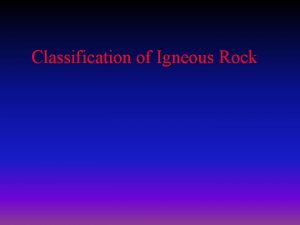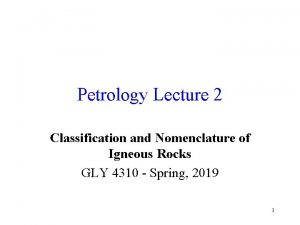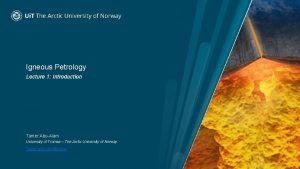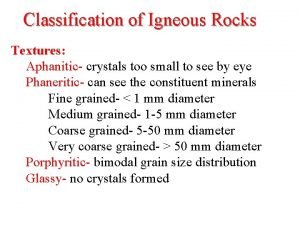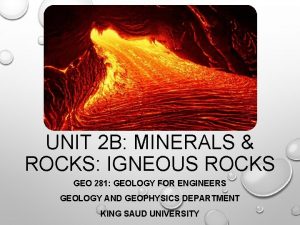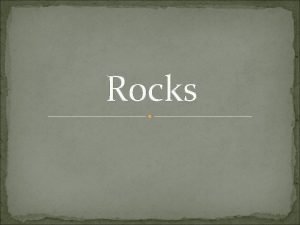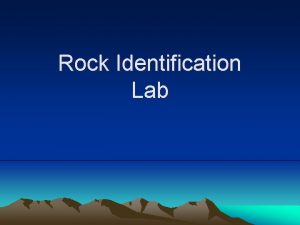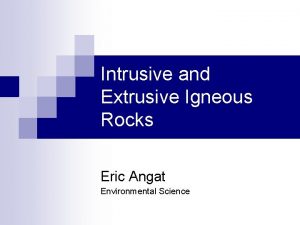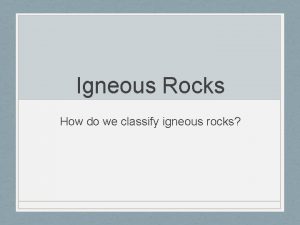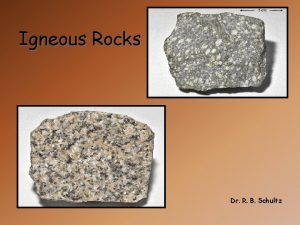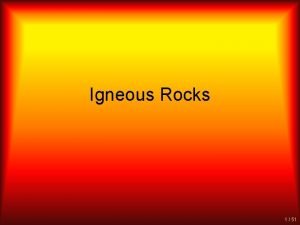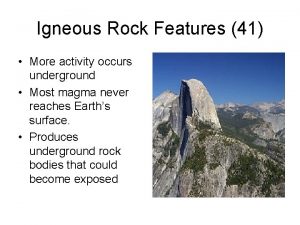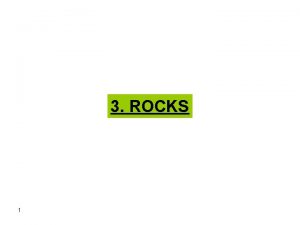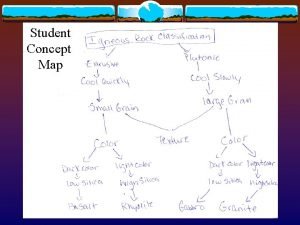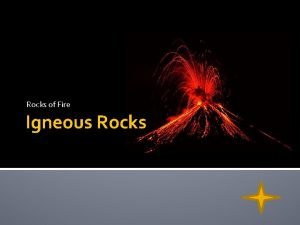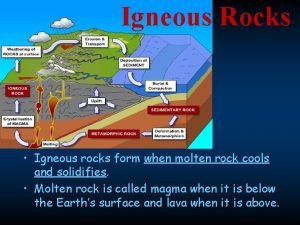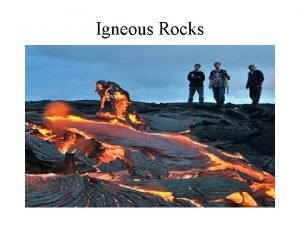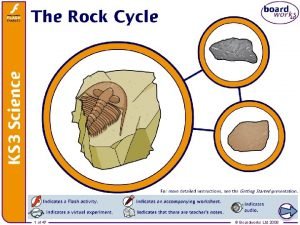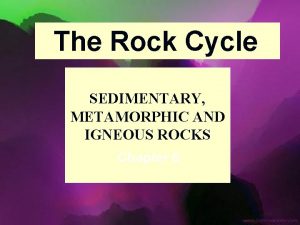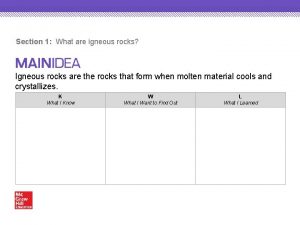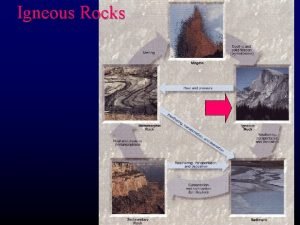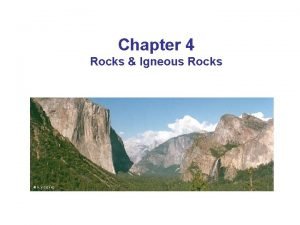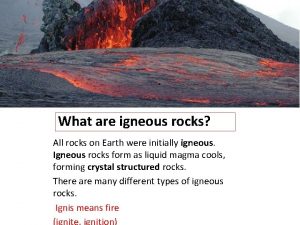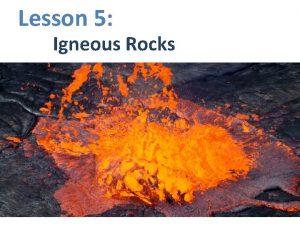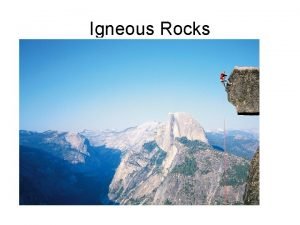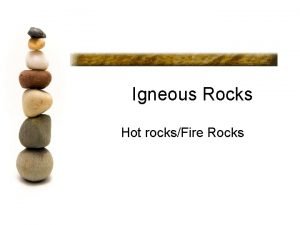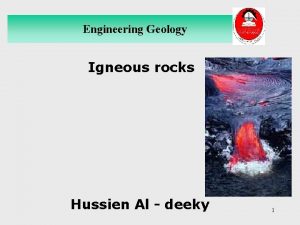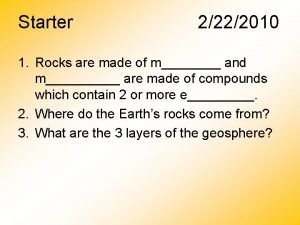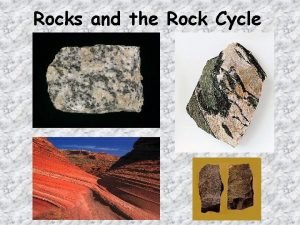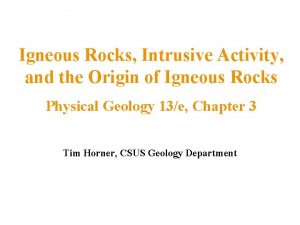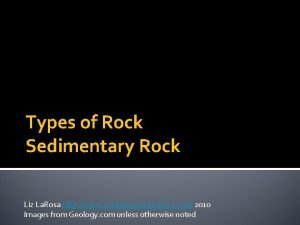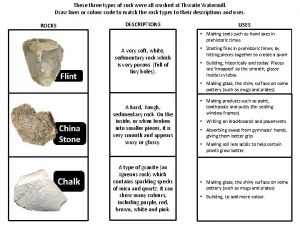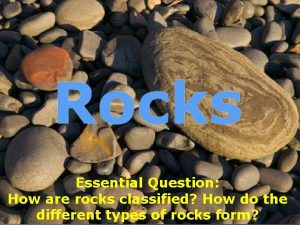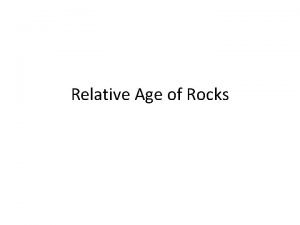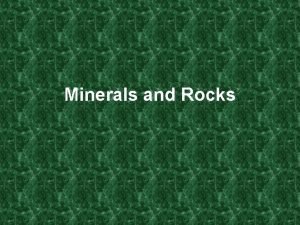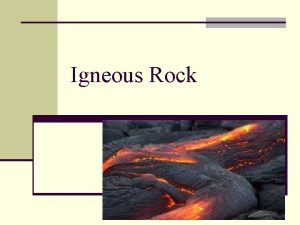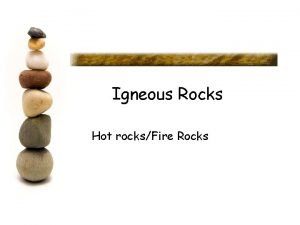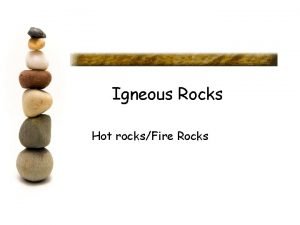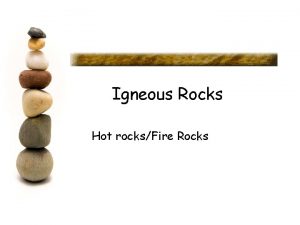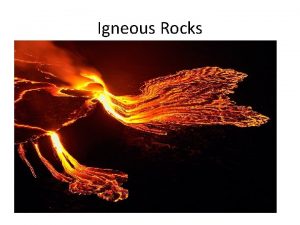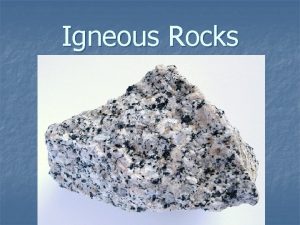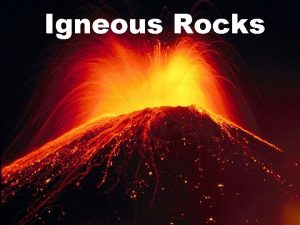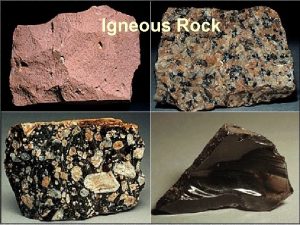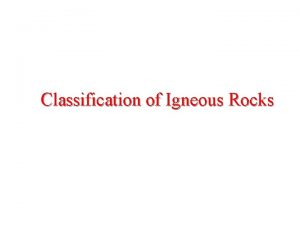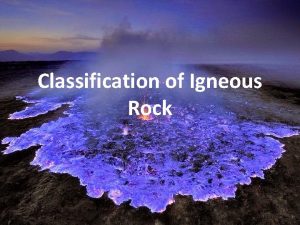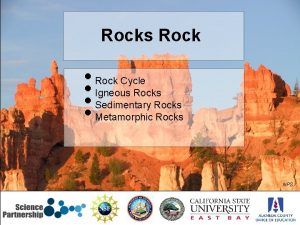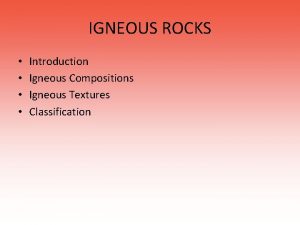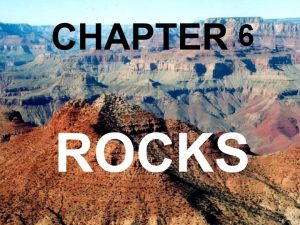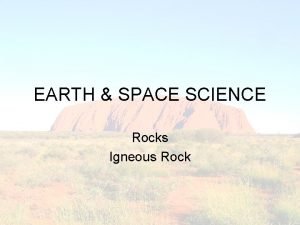Igneous Rocks Classifying rocks Rock classification usually involves


















































- Slides: 50

Igneous Rocks

Classifying rocks • Rock classification usually involves determining two parameters: – Texture: the size, shape, and relationship of the mineral grains that make up the rock – Composition: the amount/proportion of various minerals that make up the rock • True for all rocks but we’ll start with igneous rocks

Igneous rocks… • Form from magma • Lava is magma that reaches the surface and loses gasses (mostly H 2 O and CO 2) • If magma crystallizes before reaching the surface it forms an intrusive (plutonic) rock • When lava crystallizes it forms extrusive (volcanic) rock • Intrusive and extrusive rocks have different textures

Texture – intrusive rocks • • Cool slowly Crystals grow larger Texture is phaneritic (lit. “visible grains”) Must give a grain size: – Visible but less than 1 mm = fine grained (f. g. ) – Between 1 and 5 mm = medium grained (m. g. ) – Greater then 5 mm = coarse grained (c. g. ) – Greater than 2 cm = pegmatitic (see below) • Don’t have to give “phaneritic”

Texture – extrusive rocks • Cool rapidly • Crystals are small (generally too small to see) • Texture is aphanitic (lit. not visible grains) • Where lava cools very quickly (quenches) the rock will be a glass (non-crystalline) • Textural term is glassy

Phaneritic texture

Aphanitic texture

Porphyritic rocks • When magma cooling rate changes the rock will commonly show a wide variation in grain sizes • Porphyritic texture • The larger grains are phenocrysts which sit in a groundmass • In a porphyritic rock the grain size of the groundmass indicates its origin. Therefore you must indicate the grain size of the groundmass (aphanitic, phaneritic or (rarely) glassy) to denote complete texture – e. g. , f. g. porphyritic, aphanitic porphyritic, etc.

Origin of porphyritic texture

Porphyritic texture

Porphyritic textures Phenocrysts Groundmass (aphanitic)

Porphyritic textures Phenocrysts Groundmass (phaneritic)

Porphyritic texture • Very common in extrusive rocks • The magma works its way to the surface slowly (producing the phenocrysts) but the final stages of cooling on the surface are very fast (producing the groundmass) • Porphyritic texture is possible in intrusive rocks but it’s rarer and harder to see (particularly in hand samples)

Other extrusive textural terms • Extrusive rocks commonly have bubble holes (vesicles) caused by escaping gas. • Vesicular texture • Light and dark coloured vesicular rocks have different appearance and names – Light coloured vesicular rocks generally have many tiny holes. Rock is pumice (texture is pumaceous). – Dark coloured vesicular rocks have fewer and larger holes. Rock is scoria (texture is scoriaceous).

Pumice (mm sized vesicles) Scoria (cm sized vesicles)

Other special (textural) terms • Amygdaloidal: textural term used when vesicles have became filled with minerals deposited from solutions percolating through the rock • Tuff is a pyroclastic rock formed from volcanic fragments (ash) • Obsidian is a volcanic glass • Pegmatite is an intrusive rock with very large grains (cm size) – typically due to crystallisation from water-rich magma. Texture is pegmatitic

Column 1: Texture

Column 1: Texture

Column 1: Texture 1 cm

Composition • The primary compositional feature of igneous rocks is the proportion (percentage) of Fe-Mg (ferromagnesian) minerals which are dark (mostly black). • Felsic rocks contain less than 10% Fe-Mg mins. • Intermediate rocks 10 -30, 30 -40% Fe-Mg mins. • Mafic rocks have 40 -90% Fe-Mg mins. • Ultramafic rocks have >90% Fe-Mg mins.


Column 2: Is the rock F(elsic), I(intermediate), M(afic), U(ltramafic) • • What is the percentage Fe-Mg minerals? The darker the rock, the higher the % Fe-Mg minerals. Relatively easy to determine for phaneritic rocks Aphanitic rocks use colour: – Beige, pinkish, pink, red or brown: felsic – Medium grey or greenish: intermediate – Dark green or grey to black: mafic – Glass (black) is felsic – Ultramafic rocks are never aphanitic

Column 3: Feldspar Name • Phaneritic (and porphyritic) rocks: – Pink, cream, red: K-feldspar – White, pale to dark grey, greenish, bluish with striations on cleavage surfaces: plagioclase • Aphanitic rocks: – Cannot see the grains. Therefore report feldspar as n. d. = not determined. This is not the same as saying there is none. • Glassy rocks have no minerals. – Report as “none”

Column 4: Fe-Mg Mineral • Phaneritic and porphyritic rocks: name the identifiable Fe-Mg mineral(s) • Use both amount and appearance • Four choices (usually 1, sometimes 2 present): – Biotite (small amounts; felsic rocks) – Amphibole (moderate amounts, intermediate rocks) – Pyroxene (significant amounts in mafic and ultramafic rocks) – Olivine (small amounts in mafic rocks significant amounts in ultramafic rocks)

Column 4: Fe-Mg Mineral • Aphanitic rocks: – Cannot see the grains. Therefore report Fe-Mg mineral as n. d. = not determined. This is not the same as saying there is none. • Glassy rocks have no minerals. – Report as “none”

Appearance of Fe-Mg minerals • Biotite: Black, shiny, flakey • Amphibole: Black/dark green, shiny (visible cleavage surfaces), not flakey • Pyroxene: Black/dark green, dull (cleavage not readily visible), not flakey • Olivine, apple green, glassy

Column 5: % Q(uartz) • Phaneritic rocks: give the percentage quartz – Quartz is the dull grey glassy-looking mineral – The % quartz varies inversely with the amount of Fe-Mg mineral. • Felsic rocks: Significant amount of quartz, very little Fe-Mg mineral (and it’s usually biotite) • Mafic or ultramafic rocks: No quartz, abundant Fe-Mg mineral (pyroxene and/olivine) • Aphanitic rocks: report “n. d. ” not 0% • Glassy rocks: no minerals (i. e. 0% quartz).

Column 6: I(ntrusive) or E(xtrusive) • Is the rock intrusive (I) or extrusive (E)? • Rule of thumb: – Aphanitic texture => rock is extrusive – Phaneritic texture => rock is intrusive, except, mafic extrusive rocks are very commonly fine grained

Column 7: Rock Name • Use: – – the charts (on handout), examples (at back of lab), poster (back of lab, this Power. Point file), book. • Note that the name is, in some respects, the least important column of this lab. • This lab is your first introduction to igneous rocks and it is far more important to become familiar with them than to name them.


Let’s look at Sample #1

Texture?

Texture is… Coarse grained

Is it F, I, M or U? What proportion is black minerals? 0 -10% (a little) 10 -40% (more than a little but less than half) 40 -90% (most) 90 -100% (all)

It is… Coarse grained I

What is the feldspar? K-feldspar: buff, beige, pink Plagioclase: white, grey, bluish

Feldspar is… Coarse grained I Plagioclase

What is the Fe-Mg mineral? Biotite: usually not much (0 -20%), black, shiny, and flakey Amphibole: moderate amounts (10 -40%), black, shiny and elongate (rods or clumps) Pyroxene: a lot (>40%), black, dull and lumpy Olivine: green and glassy

Look with the hand-lens Looks flaky!

What is the Fe-Mg mineral? Biotite: usually not much (0 -20%), black, shiny, and flakey Amphibole: moderate amounts (10 -40%), black, shiny, and elongate (rods or clumps) Pyroxene: a lot (>40%), black, dull, and lumpy Olivine: green and glassy

Fe-Mg mineral is… Coarse grained I Plagioclase Biotite

How much quartz? Quartz is grey and glassy looking. Estimate: A bit (0 -10%) More than a bit but less than a quarter (10 -25%) More than a quarter less than half (2550%) More than half (>50%)

% Q is … Coarse grained I Plagioclase Biotite ≈20

Is it intrusive or extrusive? Since it is coarse grained it must be… Coarse grained I Plagioclase Biotite ≈20 I

Because it is intermediate and intrusive it can be… Granodiorite: less Fe-Mg minerals, probably biotite and some amphibole or Diorite: more Fe. Mg minerals, mostly amphibole

Because it is intermediate and intrusive it is… Coarse grained I Plagioclase Biotite #1 done! ≈20 I Granodiorite

Microscopes and pumice • • Look through microscopes at slides Answer questions DON’T MOVE THE SLIDES OR ROTATE THE STAGE The drawings on the board show you where to find points of interest in the field of view • Don’t confuse colourless and transparent… • With pumice “experiment” think of density – as a whole.

One final point… • It will help to use the hand lens (particularly to differentiate biotite from amphibole). • Hand lenses have a very short focal length so you must hold them close to your eye (and the sample) to see anything.

Questions?

Field trip next week • Bus departs from outside Huggins (University Avenue side) • Promptly at 1: 30 – don’t be late! • Keep an eye on the weather: – Colder on shore than in Wolfville (often 10 degrees colder) – Bring a jacket • Beach is bouldery; wear decent shoes with ankle support (not flip-flops, Birkenstocks, etc. )
 Types of igneous sedimentary and metamorphic rocks
Types of igneous sedimentary and metamorphic rocks Igneous rocks metamorphic rocks and sedimentary rocks
Igneous rocks metamorphic rocks and sedimentary rocks How does igneous rock become metamorphic rock
How does igneous rock become metamorphic rock Rock
Rock Iugs classification of igneous rocks
Iugs classification of igneous rocks Gradient
Gradient Iugs classification of igneous rocks
Iugs classification of igneous rocks Prime cost in accounting
Prime cost in accounting Igneous rock texture
Igneous rock texture Topography associated with massive igneous rocks
Topography associated with massive igneous rocks Coquina sedimentary rock type
Coquina sedimentary rock type Igneous rock identification lab
Igneous rock identification lab The rock cycle concept map
The rock cycle concept map Describe igneous rocks
Describe igneous rocks What is the definition of an igneous rock
What is the definition of an igneous rock Igneous rock colors
Igneous rock colors How is intrusive igneous rock formed
How is intrusive igneous rock formed Igneous rock texture
Igneous rock texture Type of igneous rocks
Type of igneous rocks Felsic composition
Felsic composition Intrusive igneous rock bodies are called
Intrusive igneous rock bodies are called Andesetic
Andesetic Mafic extrusive igneous rock examples
Mafic extrusive igneous rock examples Concept map about rocks
Concept map about rocks Igneous defintion
Igneous defintion Igneous rock concept map
Igneous rock concept map Igneous rocks
Igneous rocks Igneous rocks
Igneous rocks Igneous rock
Igneous rock Types of rocks foldable
Types of rocks foldable Igneous rock properties
Igneous rock properties Metamorphic sedimentary
Metamorphic sedimentary Igneous rock animation
Igneous rock animation Vesicular basalt texture
Vesicular basalt texture Bowen sequence
Bowen sequence Igneous rock formation
Igneous rock formation Molten rocks underneath
Molten rocks underneath Rock cycle
Rock cycle What is igneous rock
What is igneous rock Ultrabasic rocks
Ultrabasic rocks How igneous rocks are formed
How igneous rocks are formed Igneous rock
Igneous rock Igneous rock types
Igneous rock types Where are igneous rock found
Where are igneous rock found Igneous rock
Igneous rock Intrusive activity
Intrusive activity Concept map for igneous rocks
Concept map for igneous rocks Three types of rocks
Three types of rocks Rocks classified
Rocks classified Geologic features
Geologic features Luster of igneous rocks
Luster of igneous rocks



